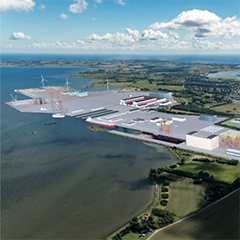Carsten Aa, chief executive officer of LINDØ port of ODENSE in Denmark, talks to PES about his vision for the site, and its expansion into a specialist cluster supporting the offshore wind industry.
PES: Welcome to PES Wind magazine, it’s great to talk with you. We would like you to begin by explaining a little about the background of LINDØ port of ODENSE and the importance of the offshore wind industry to you?
Carsten Aa: The port is owned by the local municipality. At the beginning of 2014 we bought the former shipyard, which had been owned by A.P. Moller-Maersk Group, and began to transform it from a shipyard into a port area specialising in heavy load, and in particular supporting the area’s offshore wind cluster.
We merged the two former companies, the old port and shipyard, into one new company, which we called LINDØ port of ODENSE (LPO). The port specialises in supporting the wind industry, and has nearly 200,000 square metres of production halls and storage buildings, and some of the largest cranes in Europe.
We have now re-built and renewed most of the area, and are close to completing its transformation into the most modern port area in Europe for the wind industry. We are involved both in the production of nacelles, through one of our companies MHI Vestas, as well as being the only port in Europe that has produced over 100 jackets for the offshore wind industry.
PES: Is the offshore wind market growing?
CA: Yes, it is. Although 2018 has been a quieter year for us than 2017, in terms of orders, we expect business to grow again in 2019 and in the upcoming years. As a result, we are heavily investing in the new port area to support the growing industry.
PES: LINDØ port of ODENSE itself is expanding, could you explain your plans for the growth of the port?
CA: We are investing 400 million Danish kroner in developing specialised port areas. We see this investment as necessary to meet customer demand, particularly for some of these huge offshore projects.
We are seeing a lot of specialised demand, and so to support the industry we have created heavy load areas not seen at a port anywhere else in Europe, and a 1,200-tonne gantry crane.
We are trying to focus our investment to meet not only the demand we are seeing now, but also future demand, a great part of which we believe will be in offshore wind.
PES: Is this expansion being driven by changes in the offshore wind market, and if so, how are you adapting to those changes?




























